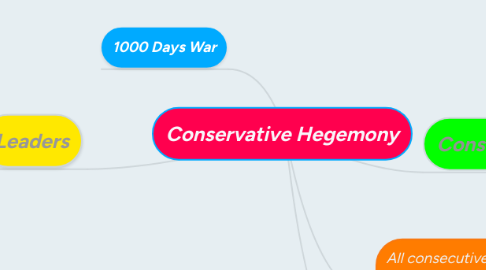
1. Leaders
1.1. Carlos Eugenio Restrepo (1910-1914)
1.1.1. Reconciliation between parties.
1.1.2. Economic prosperity. (coffee)
1.1.3. Republican.
1.1.4. Freedom of speech.
1.1.5. Free and secret ballot.
1.1.6. Practical and secular education.
1.1.7. Fairness and tolerance.
1.2. José Vicente Concha
1.2.1. Recession in prices.
1.2.2. Discontent and unemployment.
1.2.3. International relationships with Venezuela and Ecuador only.
1.2.4. Economic crisis.
1.2.5. Oil production begins.
1.3. Marco Fidel Suarez (1918-1921)
1.3.1. Income taxation.
1.3.2. Construction of roads.
1.3.3. Promoted relations with the USA.
1.3.4. Resigned.
1.3.5. Dollar rose 130%
1.4. Pedro Nel Ospina(1922-1926)
1.4.1. Responsible for "The Dance of Millions"
1.4.2. Created the Comptroller's Office.
1.4.3. Created the Bank of the Republic.
1.4.4. Economical prosperity due to coffee and oil.
1.4.5. Public Education.
1.5. Rafael Nuñes (1887-1888)
1.5.1. Responsible for the regeneration.
1.5.2. President during 4 consecutive times (1880 1888)
1.5.3. Some of his ideals were in the 1886 constitution.
1.6. Manuel Antonio Sanclemente (1898- 1900)
1.6.1. Thousand Days War.
1.6.2. Was displaced by Jose Manuel Marroquin.
1.7. Jose Manuel Marroquin (1900-1904)
1.7.1. Separation of Panama.
1.7.2. Armed conflict with guerilla groups started.
1.7.3. Colombia was suffering from an economical crisis.
1.7.4. "La Academia Colombiana de Historia" was founded by Jose Joaquín Casas.
1.8. Rafael Reyes (1904-1909)
1.8.1. "More government, less politics."
1.8.2. Attempted to end war and regionalism.
1.8.3. Focused on building new roads and railways.
1.8.4. Cared about navigation and it's improvement.
1.8.5. Encouraged domestic industry and implied protectionism.
1.8.6. Creation of new and smaller deportments.
1.8.6.1. Caldas, Huila, Atlantico and Nariño.
1.8.7. Eliminated execisve power in departments.
1.8.8. Made Bogotá the capital.
1.8.9. Created Night shift schools.
1.8.10. Gave importance to education.
1.8.11. He resigned thanks to dissatisfaction in both parties.
1.9. Jorge Holguín (1909-1909)
1.9.1. Re-elected in 1922
1.9.2. Survived a lot of wars.
1.9.3. Perfected the Urritia-Thompson treaty.
1.9.4. Found the newspaper "La Prensa"
1.10. Ramón Gonzales Valencia (1909-1910)
1.10.1. Was vice- president before he was president.
1.10.2. He created the new political party "Unión Republicana".
1.11. Miguel Abadía Méndez (1926-1930)
1.11.1. Public order was a problem.
1.11.2. The banana massacre took place.
1.11.3. Created agreements with Nicaragua, Brazil and Peru.
1.11.4. Restrained guarantees of the working clasess.
1.12. Enrique Olaya Herrera (1930-1932)
1.12.1. Protectionist to death.
1.12.2. Created rights for the workers.
1.12.3. Faced war against Peru.
1.12.4. Rio de Janerio agreement took place.
1.12.5. Tried to lift the country after the great depression.
1.13. Alfonso Lopez Pumarejo (1934-1918)
1.13.1. The ongoing revolution took place.
1.13.2. Created the labour policy.
1.13.3. Supported new international markets.
1.13.4. Tax and Judicial system.
1.13.5. Prosperity in the country.
1.13.6. Progressiveness.
